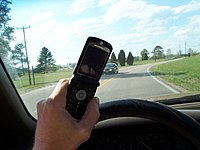
Photo from wikipedia
Abstract Naturalistic driving research shows that drivers spend vast amounts of time engaging in secondary, non-driving tasks. Laboratory and simulation studies have demonstrated that, when engaging in a secondary task,… Click to show full abstract
Abstract Naturalistic driving research shows that drivers spend vast amounts of time engaging in secondary, non-driving tasks. Laboratory and simulation studies have demonstrated that, when engaging in a secondary task, drivers adopt strategies to interrupt, delay and resume the secondary task in order to manage their workload and risk. However, there is very little knowledge of the time-sharing strategies that drivers adopt for interweaving their attention across multiple tasks in real-world driving. This study examined the nature of observable visual and/or manual secondary task interruptions in real-word driving using naturalistic driving data. Video of 186 randomly selected trips from the Australian Naturalistic Driving Study were viewed to identify a range of secondary tasks and whether, when and why drivers interrupted engagement in these secondary tasks. It was found that under everyday naturalistic driving conditions, drivers interrupt (or temporarily disengage from) only a small percentage (13.5%) of the secondary tasks engaged in, with 87 percent of these tasks interrupted to re-engage in the driving task. The number of interruptions made to secondary tasks was found to differ according to a number of task characteristics, including task duration and visual load, with tasks of longer duration and higher visual load more likely to be interrupted. The results have a range of practical implications, particularly for the design of in-vehicle devices that better support drivers to break down long tasks into a series of sub-tasks, so that they can more easily disengage when driving demands necessitate.
Journal Title: Safety Science
Year Published: 2020
Link to full text (if available)
Share on Social Media: Sign Up to like & get
recommendations!